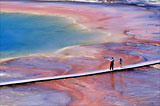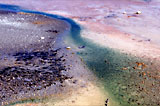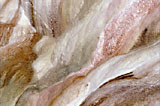
|
Lobby > Exhibits > Hot Spring Ecology > Microbes > Meet the Microbes > Sulfide-rich Carbonate Springs Meet the MicrobesSULFIDE-RICH CARBONATE SPRINGS The water at Mammoth Hot Springs, although rich in sulfate, is neither very acidic nor very alkaline because the underlying bedrock of calcium carbonate acts as a buffer and keeps the water’s pH near neutral. Some of the sulfate in the water is converted to hydrogen sulfide underground, most likely by microorganisms. Sulfide strongly influences the types of microorganisms found at Mammoth Hot Springs. Some microbes thrive on sulfide, whereas others find this chemical poisonous. The latter live downstream in areas where the sulfide has already been removed by their hungry neighbors. Becoming coated with calcium carbonate, the microorganisms also help build the travertine terraces. 
|
|
||||||||||||||||||||||||||||||||||||




